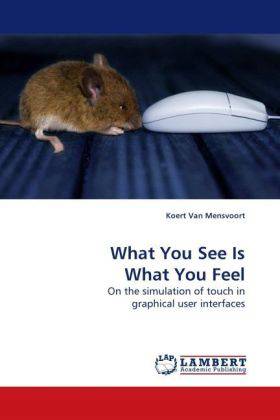
- Afhalen na 1 uur in een winkel met voorraad
- Gratis thuislevering in België vanaf € 30
- Ruim aanbod met 7 miljoen producten
- Afhalen na 1 uur in een winkel met voorraad
- Gratis thuislevering in België vanaf € 30
- Ruim aanbod met 7 miljoen producten
Zoeken
What You See Is What You Feel
On the simulation of touch in graphical user interfaces
Koert Van Mensvoort
Paperback | Engels
€ 58,45
+ 116 punten
Omschrijving
With the introduction of the desktop metaphor, computers have become accessible for almost anyone; all over the world, people from various cultures use the same icons, folders, buttons and trash cans. From a sensorial point of view, however, this computing paradigm is still extremely limited. Inspired by renaissance painters who centuries ago already applied various types of optical illusions in order to enhance the expressiveness of their paintings we introduce a method of simulating touch with merely visual means. Interactive animations are used to create an optical illusion that evokes haptic percepts like stickiness, stiffness and mass, within a standard graphical user interface. This technique, called optically simulated hapic feedback, exploits the domination of the visual over the haptic modality and the human tendency to integrate between the various senses. Experiments show that the method can be a good alternative for mechanical force feedback devices. Furthermore, the study reflect upon the increasing role of media and simulations in our everyday lives.
Specificaties
Betrokkenen
- Auteur(s):
- Uitgeverij:
Inhoud
- Aantal bladzijden:
- 148
- Taal:
- Engels
Eigenschappen
- Productcode (EAN):
- 9783838325514
- Uitvoering:
- Paperback
- Afmetingen:
- 150 mm x 220 mm
- Gewicht:
- 213 g

Alleen bij Standaard Boekhandel
+ 116 punten op je klantenkaart van Standaard Boekhandel
Beoordelingen
We publiceren alleen reviews die voldoen aan de voorwaarden voor reviews. Bekijk onze voorwaarden voor reviews.











